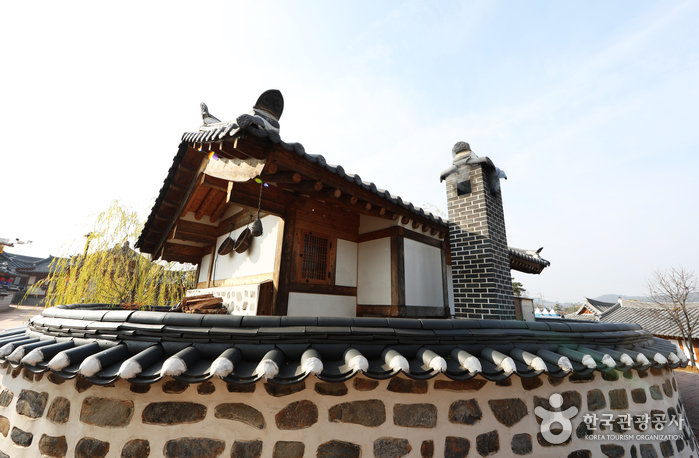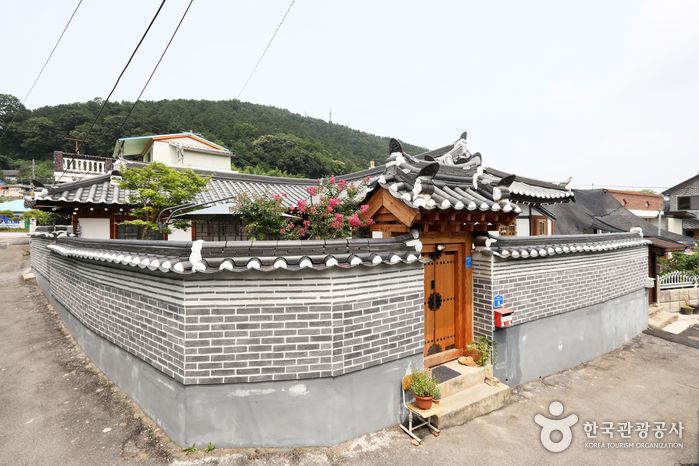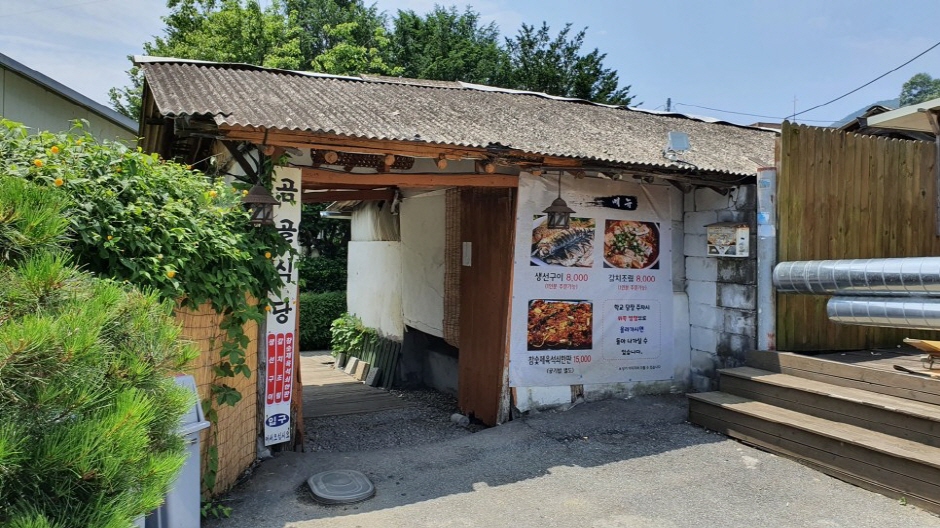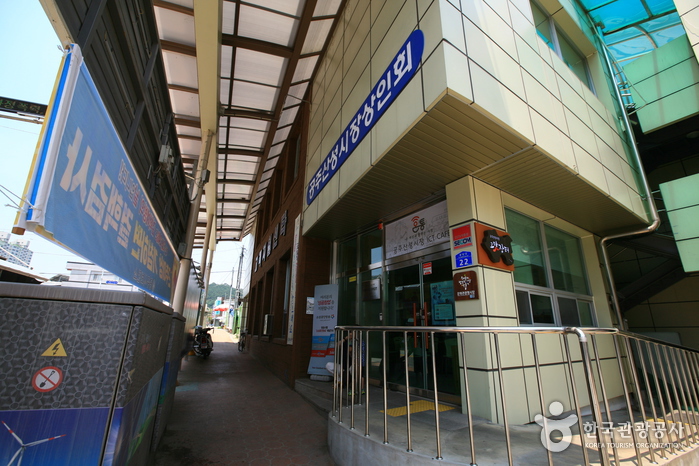Gongju Hanok Village (공주한옥마을)
18.3Km 2024-12-23
12 , Gwangwangdanji-gil, Gongju-si, Chungcheongnam-do
+82-41-881-2828
Gongju Hanok Village is in Gongju, Chungcheonnam-do, midway between the Songsan Ancient Tombs - burial place of King Muryeong of Baekje and his queen - and Gongju National Museum. The hanok are ondol-heated and have a card key security system. The village offers both individual and group accommodation, each in a different building; in the group buiding each room has a separate locker room and shower. Baekje history and culture programs on offer include a Baekje costumes experience, a royal tea ceremony, royal candies and Baekje relics.
Baekje Experience Center (백제오감체험관)
18.5Km 2024-01-08
30 Gomanaru-gil, Gongju-si, Chungcheongnam-do
The Baekje Experience Center offers a rich array of activities that allow visitors to engage with the history they have observed at the nearby ancient tombs in Songsan-ri and the Gongju National Museum in a tactile manner. This center features eight themed halls across the first basement, and the first and second above-ground floors, offering interactive and gaming programs designed to stimulate all five senses. Activities such as rubbing pattern experience and luminous stamps allow visitors to learn about and appreciate the culture and history of Woongjin Baekje in an intuitive way. One of the center’s highlights is the Window of Sympathy in the first-floor lobby. This impressive two-story panel changes its color in response to sound and touch, promising to attract significant attention from tech-savvy visitors. It showcases content that guests have captured within the center and shared on social media, complete with hashtags. Additionally, the Window of Creation on the same floor offers a unique creative outlet. Here, visitors can color Baekje-era relics with crayons. These artworks are then transformed into graphic mapping images on the wall via a scanner, allowing for a personalized and immersive historical experience.
Magoksa Temple [UNESCO World Heritage] (마곡사 [유네스코 세계문화유산])
18.5Km 2025-06-10
966 Magoksa-ro, Sagok-myeon, Gongju-si, Chungcheongnam-do
+82-41-841-6220
Situated at the foot of Taehwasan Mountain in Gongju, Magoksa Temple was established in 640. It is reputed to protect its occupants from war, and indeed, the temple survived the Japanese invasion of Korea (also known as the Imjin War; 1592-1598) and the Korean War (1950-1953). It houses numerous cultural heritage items, and visitors can participate in the Templestay program to experience life in a Korean Buddhist temple.
Gongju National Museum (국립공주박물관)
18.6Km 2021-05-20
34, Gwangwangdanji-gil, Gongju-si, Chungcheongnam-do
+82-41-850-6300
Gongju National Museum preserves and displays cultural treasures, as well as provides educational programs for locals. The museum collection includes over 10,000 relics, including 19 National Treasures and three Treasures, all excavated from the Chungcheongnam-do & Daejeon areas. The most important of these artifacts are displayed permanently, while the remaining items rotate with special exhibitions. In front of the main building is a garden visitors can enjoy after touring the museum.
Gongju Tomb of King Muryeong and Royal Tombs [UNESCO World Heritage] (공주 송산리 고분군과 무령왕릉 [유네스코 세계문화유산])
18.7Km 2024-01-08
37-2 Wangreung-ro, Gongju-si, Chungcheongnam-do
The Songsan-ri Tombs and Royal Tomb of King Muryeong (r. 462-523) contain representative relics of the Baekje period (234-678). The Songsan-ri Tombs contain the graves of kings from the period when Baekje's capital was Gongju, and it is believed to contain 17 such graves. Only seven graves have been discovered so far. There are two types of tomb designs: traditional Baekje-style rock and earth fortification tomb and Chinese-influenced rock tomb. The tombs number one to five were made using the traditional Baekje-style design while tomb number six and the Royal Tomb of King Muryeong were made using the Chinese-influenced design. Even though many artifacts were stolen from the tombs, the tombs serve as an important evidence of Baekje culture and the foreign exchanges from during that period.
Bonghwangjae Hanok Guesthouse (봉황재 한옥 게스트하우스)
18.9Km 2024-12-23
8 , Keunsaem 3-gil, Gongju-si, Chungcheongnam-do
+82-41-960-5525
Bonghwangjae is a hanok guesthouse is in Gongju, Chungcheongnam-do. It has four guestrooms, including a master bedroom with an attic that is mainly used by families. The other rooms are smaller in size, but one has a wooden veranda. Each room has a bathroom and toilet, and the big wooden-floored hall, the kitchen, and of course the yard are shared spaces. A simple free breakfast is provided. A walking tour round the old city of Gongju is offered by the owner - as is advice on where and how to take the best photos. The main tourist attractions of Gongju can all be reached on foot.
Restaurant Gomgol (곰골식당)
18.9Km 2024-01-09
1-2 Bonghwangsan 1-gil, Gongju-si, Chungcheongnam-do
This renowned restaurant in Gongju is always bustling. Upon passing through its old, time-honored main gate, one is greeted by a tastefully minimalist garden leading to the eatery itself. The restaurant boasts a carefully selected main menu, offering just three specialty dishes: charcoal-grilled spicy pork, grilled fish, and braised cutlassfish. Each meal is accompanied by an abundant array of ssam (wrap) vegetables and delicious side dishes, available for unlimited refills at the self-service bar. The charcoal-grilled spicy pork is expertly cooked for immediate enjoyment, without the need for diners to grill it themselves. The smoky aroma of the charcoal complements the subtle seasonings perfectly. The grilled fish offers a delightful contrast with its crispy skin and succulent flesh. An additional perk is the option to order single servings of all menu items.
Former Gongju-eup Office (옛 공주읍사무소)
19.1Km 2025-02-04
8 Ucheguk-gil, Gongju-si, Chungcheongnam-do
The Former Gongju-eup Office, a two-story Western-style red brick building built in 1923, stands as a symbol of Gongju’s modern history. Its interior showcases old photographs of Gongju, antique furniture, and a model of the current city. It also serves as a central venue for the annual Gongju Culture Night, held every fall, featuring performances, hands-on activities, and a flea market.
Gongju Sanseong Market (공주산성시장)
19.3Km 2024-06-05
22 Yongdang-gil, Gongju-si, Chungcheongnam-do
Opened in 1937, this expansive market features a variety of items across its five sections. It’s conveniently located near tourist attractions like Gongju National Museum, Gongsanseong Fortress, and Tomb of King Muryeong. The arcade-style roof allows for comfortable exploration in any weather or season. The Food Alley offers an irresistible selection of local delicacies, making it hard to choose from options like gimbap, banquet noodles, and bulgogi. Not to be missed are Gongju’s specialties: chestnut makgeolli (rice wine) and chestnut sweet rice cake, made from local chestnuts.
Chungcheongnam-do Museum of History (충청남도역사박물관)
19.5Km 2025-02-04
24 Gukgogae-gil, Gongju-si, Chungcheongnam-do
The Chungcheongnam-do History Museum displays historical artifacts, everyday items, folk traditions, crafts, documents, paintings, and sculptures from the Middle Ages to the modern era found in Chungcheongnam-do. Its facilities include exhibition halls, a lounge, an experience room, a performance hall, and an outdoor garden. Visitors can enjoy traditional Korean games like yunnori (traditional Korean board game) and tuho (arrow-throwing). In spring, the museum hosts a cherry blossom festival in the outdoor garden during the blooming season.



![Gongju Tomb of King Muryeong and Royal Tombs [UNESCO World Heritage] (공주 송산리 고분군과 무령왕릉 [유네스코 세계문화유산])](http://tong.visitkorea.or.kr/cms/resource/95/2678695_image2_1.jpg)



 English
English
 한국어
한국어 日本語
日本語 中文(简体)
中文(简体) Deutsch
Deutsch Français
Français Español
Español Русский
Русский